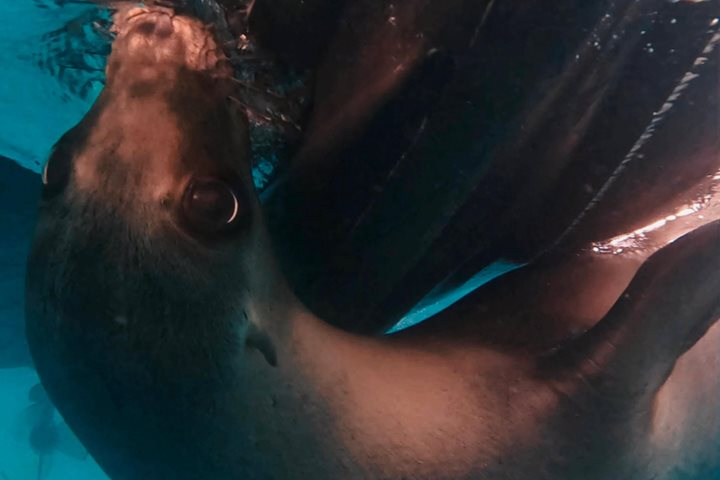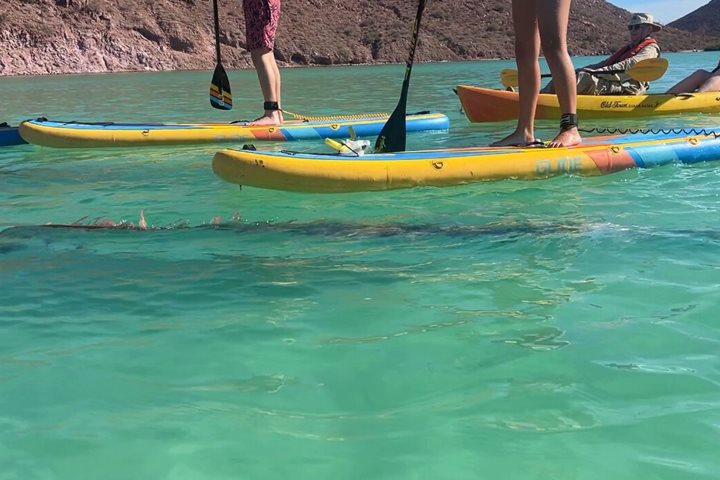Los Islotes and Isla Espiritu Santo
The National Geographic Sea Bird left her anchorage at 3a.m. this morning, heading south for our morning destination of Los Islotes, located at the northern tip of a group of islands that are part of Espiritu Santo Island Biosphere and Reserve. Los Islotes is a small islet teeming with life. It is the most southern and smallest California sea lion haul-out in the Gulf of California. Approximately 300 animals call this tiny volcanic island home; along with blue-footed boobies, brown boobies, great blue herons, turkey vultures, yellow-footed gulls and the occasional magnificent frigatebird.
Our first activity of the day would be Zodiac tours around Los Islotes. The sea lions are habituated to human presence, so four Zodiacs with guests bearing large cameras was hardly noticed! All manor of sea lion behavior was observed. The seas were very calm, allowing for easy maneuvering by drivers, giving everyone wonderful views and outstanding opportunities for great photography.
The second half of the morning was spent snorkeling with sea lions. Four full loads of anxious snorkelers arrived at the snorkel platform, ready for the life-changing experience of being in the water in close proximity to California sea lions. Several young animals spent time under, in between, and on top of the Zodiacs as snorkelers swam in the waters around Los Islotes. Visibility was excellent as humans and sea lions took time to float in close observation of each other...laughter ringing out everywhere!
In the late morning, once all gear and guests were back aboard, the Sea Bird lifted her anchor and began a slow passage down the west side of Isla Partida and Isla Espiritu Santo. We were headed for a bay at the southern end of the island called Bahia Bonanza. The afternoon was intended to be spent kayaking, snorkeling, and enjoying a gorgeous 3-mile-long white sand beach.
Just as the National Geographic Sea Bird was on approach to Bahia Bonanza our expedition leader, along with the bridge officers, spotted a blue whale...the bow was immediately filled with guests, staff and crew as we all watched the world’s largest mammal rise to the surface, release a tall, columnar blow and then move gracefully through the water, revealing a massive fluke before diving for a minimum of 15 minutes. For the next hour everyone remained on the bow, watching as this graceful and very large marine mammal surfaced, took a deep and easily audible breath, then dove deep into the sea.
Our afternoon was slightly delayed because of a blue whale sighting, and no one seemed to mind a shortening of the afternoon’s activities. As the National Geographic Sea Bird prepared to anchor in Bahia Bonanza, gear for the beach was being prepared on the lido deck of the ship. Shortly after arrival, kayaks were dropped and towed ashore, while Zodiacs began ferrying everyone to the beach.
As we all enjoyed slightly abbreviated activities, the crew and staff of the Sea Bird were bringing all necessary equipment ashore for an evening barbecue. The sun was moving rapidly towards sunset as the nearly full moon began its rise in the eastern sky. Walkers began returning slowly from a long walk in the late afternoon light...watching the end-of-winter shadows lengthen on the beach. The galley prepared yet another unforgettable feast, while the boatswain started a beach bonfire. As the moon rose in the night sky one of our Mexican staff stepped forward to tell a creation myth about the beginning of the peoples of Mexico. This included, of course, the story of the rabbit in the moon...which tonight, was brightly shining down on this desert island; it’s watery edges tipped in glittering moonlight.






